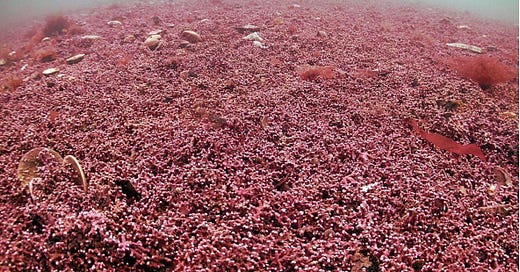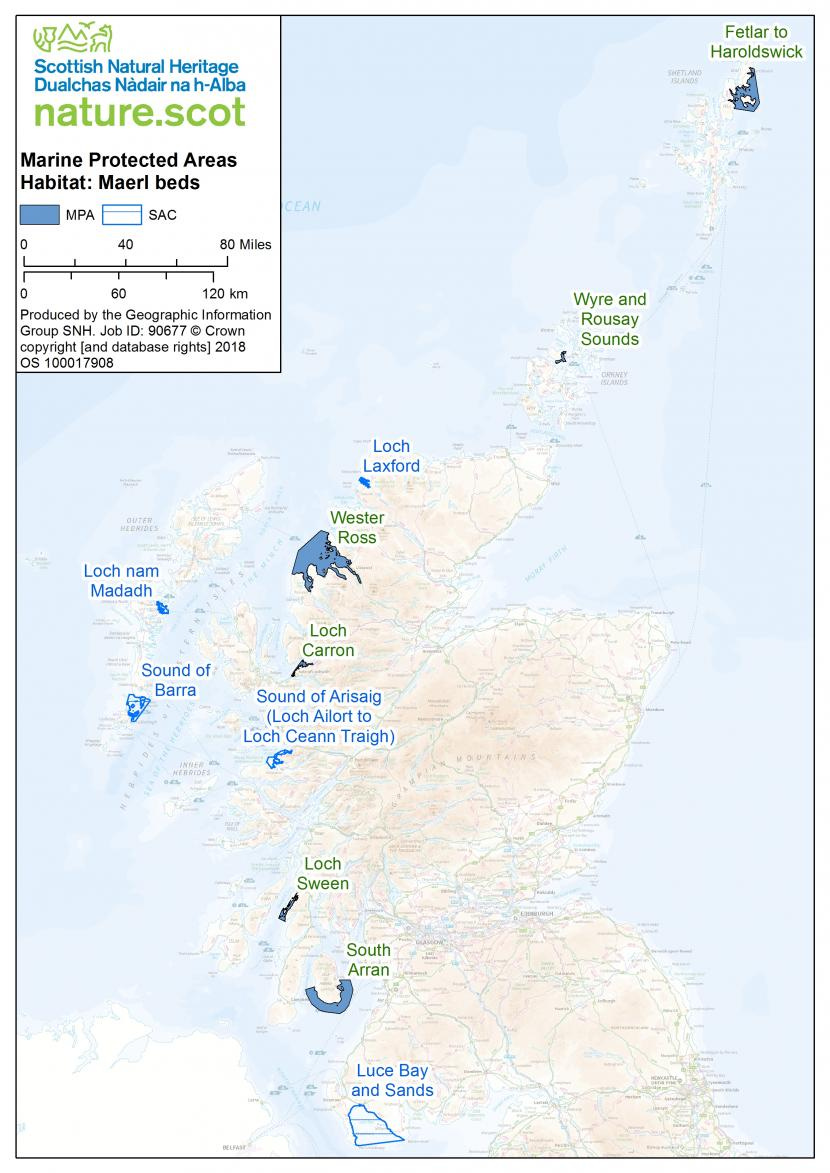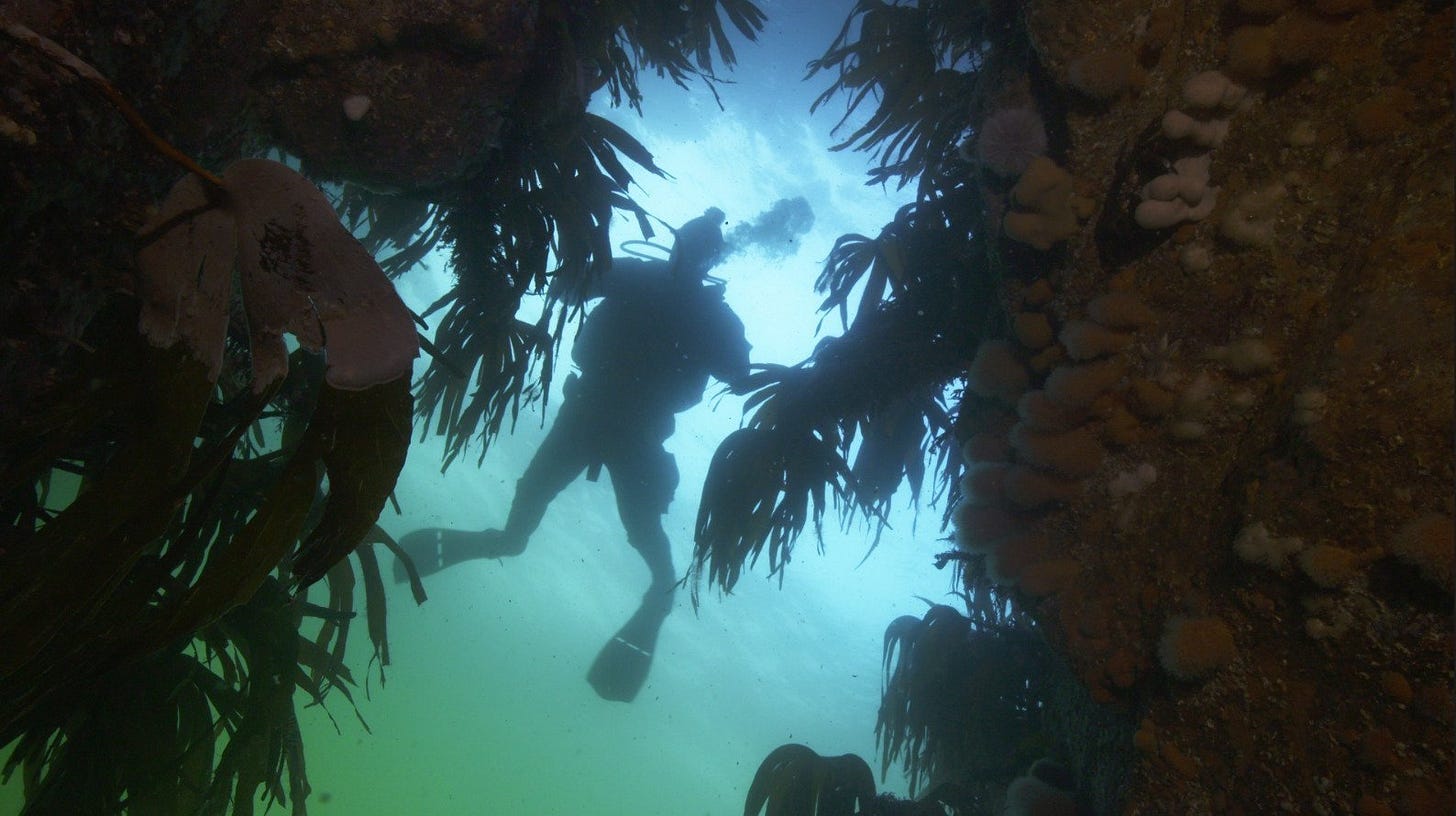Have you ever heard of maerl? No? How about the Great Barrier Reef, have you ever heard of the Great Barrier Reef? Of course you have. Now imagine that, just off the shores of Scotland’s Wester Ross, there lie habitats that are as important and precious as Australia’s famed reef: the wondrous maerl beds.
To begin with, maerl is not actually a coral, but a coral-like seaweed. NatureScot explains that “maerl deposits lime in its cell walls as it grows, creating a hard, brittle skeleton. Maerl beds are a priority marine feature in Scotland’s seas.”
Maerl grows slowly, very slowly, by about 1 millimeter per year. To put it differently, that’s 5 centimeters in 50 years! So you see, even a small piece of maerl may already be a few hundred years old. These masterfully woven submarine maerl landscapes can grow several meters thick - but whether thick or thin, they provide habitats that are valued by many species as living space, as spawning, nursing and hunting ground.
World-leading maerl expert Professor Jason Hall-Spencer of Plymouth University says that carbon dating shows that some of Scotland’s maerl beds have been growing since the last ice age.
“Maerl is the jewel in the crown of Scotland’s natural heritage. The reason I say this is because it is so very, very long lived. It forms ancient habitats and harbors enormous diversity of marine life.” (Professor Jason Hall-Spencer)
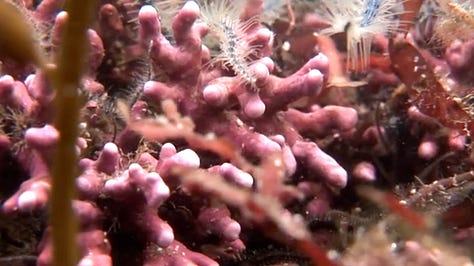



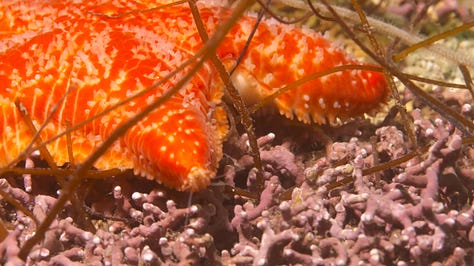


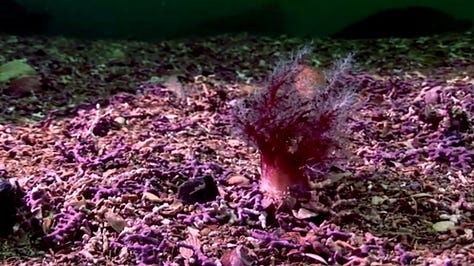

There’s all of that on one hand, on the other there is that maerl beds are destroyed by bottom trawlers (scallop dredgers). Maerl has also been extracted for centuries for use as agricultural fertilizer. This, by the way, isn’t some forgotten medieval practice. In England’s Cornwall, the removal of maerl took place since the seventies - it was banned in 2005. And France extracted 500’000 tonnes annually until the practice was prohibited in 2011. Remember the maerl’s extremely slow growth? Now imagine the scale of destruction … and imagine the thousands of years it’ll take for devastated maerl beds to recover.
When I was up in Scotland’s Wester Ross, I met up with two members of the Blue Hope Alliance - a large collaboration of groups passionately engaged in diver-surveying, documenting, monitoring and safeguarding the Wester Ross Marine Protected Area (MPA) as well as maerl beds across the northwest of Scotland. Knowing how endangered maerl is, they have become its guardian eyes underwater.
What makes the Blue Hope Alliance unique is that they dived maerl beds for over a decade by now, and have collected an extensive time series of surveys as crucial evidence. For our get-together in Gairloch, Nicky Middleton-Jones, the alliance project officer, brought along the Blue Hope Alliance coordinator, founding member and filmmaker Sara Nason.
While we often see the destructive side of humanity in the news, our species’ greatest strength is actually that of collaboration - of working together to make things better, to progress and, sometimes, to protect. That’s exactly what the Blue Hope Alliance does. Nicky and Sara explained that they are, “a coalition of marine stakeholders working together as volunteer citizen scientists to document and monitor maerl in the Northwest Highlands. We bring together sustainable fishers, fishery boards, community survey groups, and marine scientists.”
Scotland’s Wester Ross MPA (see image) is the largest maerl protection zone in the world. The importance of the maerl beds, and the home they provide for so much of the marine life, has long been known to local fishermen. But it was only just ten years ago that this MPA was officially closed to trawlers and dredgers.
The Blue Hope Alliance formed organically out of the organizations that managed to secure the closure of the MPA to scallop dredgers and confine trawlers to boxes. Ever since, the alliance is engaged in defending maerl’s recovery from a) illegal dredging and the expansion of fish farms that are still allowed to operate inside the MPA. Blue Hope Alliance divers and supporters have been successful in documenting illegal dredging by diving and filming the destruction that had been devastatingly torn across the seabed.
One moment there had been vast meadows of pink maerl habitat, teeming with life, the next all that was left was grey death as far as the GoPro camera could see. Capturing that destruction of maerl was the final straw - and it led to a complete dredge ban that parliament ratified in 2016.
Nicky and Sara shared that the Blue Hope Alliance will celebrate its ten-year anniversary next year - together with the MPA’s maerl recovery birthday. What they have done, and what they continue to do, looks like best practice to me. Local communities are often confronted with impositions and injustices and, most often, feel powerless against monied outside forces. But when people come together not to just to vent, but to act positively toward a better way, then good things tend to happen.
They not only monitor to ensure the ban’s efficacy, the alliance also empowers local communities to participate in taking more care of the seas, as Nicky said, “with the tools and knowledge to not only become custodians of the sea but also to become advocates for its protection, encouraging real local democracy in marine management.”
Case in point: The Blue Hope Alliance offers an open-source archive with documentation, with underwater photography and video footage going back to 2015. Of photos alone there are 12,000 that document maerl and other vital habitats. The alliance’s photos above are thanks to the generosity of divers willing to share their work for the public good. This open-source community-owned archive is unique in the UK and offers insights to inform policymakers, as well as to educate and inspire the public.
While the Wester Ross Marine Protected Area clearly is a success story, all’s not well. As mentioned before, recovery of a devastated maerl bed, if it manages to recover at all, takes thousands of years. The Scottish government’s management objectives for the MPA are to “recover” maerl … but the Blue Hope Alliance’s monitoring shows that the real status of maerl beds is not “recover”, but remains “decline”. Fish farms may be at the center of the problem.
When I was up there, I saw several fish farms at a distance - and I’ll invite you to watch the linked video with Professor Hall-Spencer. (who advocates for and advises the Blue Hope Alliance, as they share the mission of putting maerl on the global map).
The presentation actually nicely illustrates how the alliance works: they organized the talk, filmed it, and illustrated it with their survey footage. In this way the local community was presented with facts gathered locally and by their own, enriched with the professor’s peer-reviewed scientific evidence. A great way of making effective use of their BHA’s extensive survey material.
In his talk, the professor takes you into the world of maerl and then, as of min 10:30, he addresses the topic of fish farms and their impact on maerl beds. As it turns out, the salmon on those farms like the very same conditions as does maerl. And everything that gets dropped (nutrients and feces and chemicals to fight fish lice) from those fish farms, ends up covering - and killing - maerl.
The professor was tasked by the government to do the research, did the work and delivered his findings. “I gave them the scientific evidence,” he says, “and yet they still give out licenses for fish farms on maerl beds.” Watch the above-linked video to the end, the professor makes some excellent points. I will definitely do a deep-dive into the fish farming topic sometime soon. For now I can tell you one thing, even just knowing what I now know will make me reconsider a hundred times over, before ever eating farmed salmon again. Before closing, I’d like to share Sara’s appeal:
“Giant Norwegian Multinationals have salmon farms within the Marine Protected Area and outside too. Even without expansion our maerl beds are stressed and damaged – smothered by filamentous algae – growth caused by high nutrients in the seawater. We do not need more nutrients - given the situation already needing to be addressed. We’ve just screened a decade of survey footage to the Scottish government agency, Nature Scot, to show maerl decline from 2016-2024. Next we’re advocating for the precautionary principle whilst we pin the evidence down and find the sources of nutrients before knowing the actions needed.
“If the source is fish farms then disposal of farm waste in the sea will need cutting. However a large hatchery is looming large over the MPA with its discharges still uncertain. Rachel Carson, who wrote Silent Spring, saw that we are inseparable from our environment and are polluting ourselves - she noted that it is often ordinary observers who are first see what is really happening on their doorstep. If fish farms prove to be a silent killer of the maerl plant, through suffocation by algae - then this problem will have been creeping up on us for ages. It may not have the obvious and immediate wallop of scallop dredgers, but its just as destructive.
“We’ve found that, if we want policy led by evidence, we have to get it ourselves. And If we want generations of fish, cetaceans, herring, cod, haddock, salmon, people and communities to recover – we need to take a stand for maerl. This summer Blue Hope Alliance divers will collaborate with the Honeydew live-aboard dive-boat scientists to pin down the evidence which we urgently need to find out what will secure maerl’s recovery. For me this is like a modern day version of Cousteau’s Calypso - critical to get the science we need and tell the story.
“But we urgently need support, for our surveys, films and project officer to succeed. Please get in touch and join us if you can help in any way.”
A thousand thanks to Nicky and Sara for opening my eyes to a whole new world, the fascinating world of maerl. Sara, by the way, is in the process of finalizing a documentary she’s been working on for five years and I have to say I can’t wait to see it!
Cheers,
If you enjoy the Rewilder Weekly …
… consider supporting my work. Your paid subscription will help generate the funds needed to realize a unique rewilding book I’m working on. And, of course, that paid subscription also ensures that the Rewilder Weekly will always keep going for those who cannot afford to pay. A thousand thanks!


